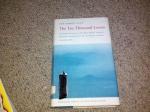|
This section contains 1,204 words (approx. 5 pages at 300 words per page) |

|
SOURCE: Ceadel, Eric B. “Japanese Literature.” In Literature of the East, An Appreciation, edited by Eric B. Ceadel, pp. 161-88. London: John Murray (Publishers) Ltd., 1953.
In the following excerpt, Ceadel comments on the distinctive qualities of the long and short poems in the Man'yōshū.
… The waka is a poem consisting of a succession of pairs of five-syllabled and seven-syllabled lines, the end of the poem being marked by an extra line of seven syllables. This alternation between lines of five syllables and lines of seven syllables was virtually the only technical requirement, and such factors as rhyme, stress, rhythmical feet, and so on, which are essential in the poetry of many countries, play no part in the waka. Yet this simple device of alternation between the lengths of lines, with the assistance of the nature of the Japanese language,1 proved a most successful poetical form: it produces...
|
This section contains 1,204 words (approx. 5 pages at 300 words per page) |

|


